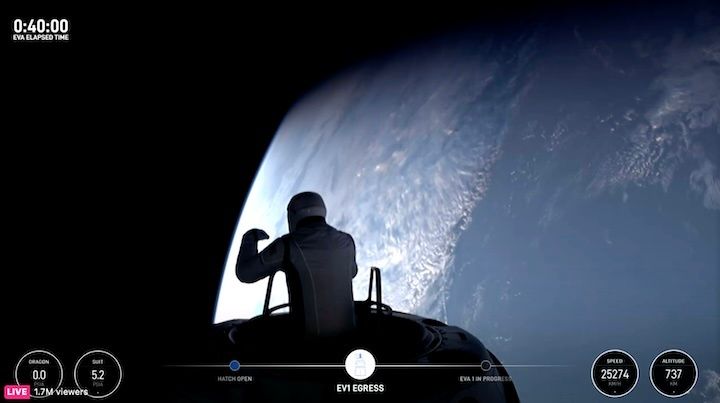14.09.2024

Quelle: SpaceX
Two astronauts have carried out the first-ever commercial spacewalk, using new less-bulky spacesuits designed by SpaceX.
Tech billionaire Jared Isaacman (who also funded the mission) and SpaceX engineer Sarah Gillis together spent almost half an hour outside their spacecraft at an altitude of some 700 km, further from Earth than any human since the Apollo Moon landings.
The brief jaunt into the void is a significant milestone for commercial spaceflight, with the spacecraft, suits and the overall mission all being SpaceX productions.
What’s so interesting about the mission?
The Polaris Dawn mission stands out for several reasons. In terms of science and technology, the highlight is the test of new spacesuits for extravehicular activity (or EVA). A spacesuit that allows an astronaut to leave their vessel is a small spacecraft in its own right, and interest in new, modern suits is growing as NASA’s planned Artemis missions to the Moon approach.
The mission is travelling around Earth in a highly elliptical orbit, which means its altitude ranges from 192 km way out to 1,400 km. The orbit is taking astronauts through regions of high radiation, including the South Atlantic Anomaly, and may allow for testing of the new suits under these extreme conditions.
Polaris Dawn also carries 36 different experiments, many studying the effects of spaceflight on the human body.
Polaris Dawn is the first of three missions Isaacman plans with SpaceX, which he says will “serve the bigger purpose of opening up space for everyone and making humankind a multiplanetary species”. The second may aim to boost the Hubble Space Telescope’s orbit and prolong its life, while the third may use SpaceX’s reusable Starship rocket (which is currently in the early stages of testing).
Commercial spaceflight on the way up
Perhaps the most significant thing about Polaris Dawn is what it suggests about the future of spaceflight. This is a commercial mission, operated by SpaceX using its own technology without the involvement of government space agencies.
It is not the “space tourism” we have seen from the likes of Blue Origin, sending rich people on sub-orbital joyrides. While the SpaceX mission is funded via private wealth, it is making a genuine contribution to scientific knowledge – and to the future of spaceflight.
One crucial feature of government space programs has been the rigorous training and selection process for astronauts, ensuring those who make it to space know exactly what they are doing. SpaceX is continuing this high level of professionalism, with four extremely well-qualified and prepared astronauts participating in Polaris Dawn.
The Polaris Dawn spacewalk comes as two NASA astronauts are stranded on the International Space Station due to problems with the Starliner space vehicle, which Boeing built for the US space agency at great expense. It is now expected the pair will be rescued next February by a SpaceX vehicle (developed for far less money than Boeing’s).
For all humankind?
The rise of non-government space flight has its critics, who say commercial imperatives and private control have no place in what should be a purely scientific endeavour. SpaceX (with its controversial owner Elon Musk) has also faced criticisms over environmental concerns and treatment of staff.
However, the huge improvements in space technology and reductions in cost that have occurred in recent years are largely due to commercial involvement. When humanity returns to the Moon – and if we one day travel to Mars and beyond – private companies will play an essential role.
And while Polaris Dawn is clearly a passion project for Isaacman, it’s not a vanity project. It will have real benefits in terms of science and technology – and that’s good news for all future human endeavours, in space and here on Earth.
Quelle: The Conversation
